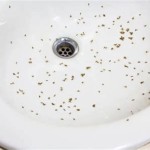How to Paint a Wooden Bathroom Vanity
Rejuvenating a wooden bathroom vanity with a fresh coat of paint is a cost-effective way to transform the bathroom's aesthetic. Achieving a professional-looking finish requires attention to essential aspects, including surface preparation, paint selection, application techniques, and hardware updates.
This article will delve into the crucial steps involved in painting a wooden bathroom vanity, providing detailed guidance and highlighting the significance of each aspect.
1. Surface Preparation: A Foundation for Success
Adequate surface preparation ensures a smooth and durable paint finish. It involves cleaning the vanity to remove dirt and grime, sanding to create a slightly rough surface for paint adhesion, and filling any cracks or holes with wood filler. This thorough preparation creates a solid base for the upcoming paint layers.
2. Paint Selection: Choosing the Right Finish
Choosing the appropriate paint finish is essential for both aesthetics and durability. For bathrooms, a satin or semi-gloss finish offers a balance between sheen and resistance to moisture. Eggshell or matte finishes provide a more subtle look but may require more frequent touch-ups in high-traffic areas.
3. Application Techniques: Achieving a Professional Finish
Proper application techniques are crucial for a flawless paint job. Begin by applying a thin coat of primer to enhance adhesion and minimize paint absorption. Use a high-quality brush or roller for even application, and allow each coat to dry completely before applying the next.
4. Hardware Updates: Enhancing Style and Functionality
Replacing old or outdated hardware can significantly update the look of the vanity. Choose hardware that complements the new paint color and style of the bathroom. Consider adding knobs, handles, or even a new faucet to complete the transformation.
5. Final Touches: Protection and Maintenance
To protect the newly painted vanity and ensure its longevity, apply a clear sealant or polyurethane finish. This extra layer provides resistance to moisture, scratches, and stains. Regular cleaning with a mild detergent and avoiding harsh chemicals will help maintain the vanity's pristine appearance.
Conclusion
Painting a wooden bathroom vanity requires careful attention to essential aspects that contribute to a professional-looking and durable finish. By following the steps outlined above—surface preparation, paint selection, application techniques, hardware updates, and final touches—you can transform your bathroom vanity into a stylish and functional piece that will enhance the overall ambiance of the room.

How To Paint A Bathroom Vanity Love Remodeled

How To Paint Bathroom Vanity Cabinets Tutorial Benjamin Moore
.jpg?strip=all)
Painting A Bathroom Vanity Again Dream Green Diy

How To Paint Bathroom Cabinets Without Sanding 8 Vital Steps Grace In My Space

How To Paint Cabinets Last Painting A Bathroom Vanity Maison De Pax

Painting Bathroom Cabinets Nq Property Care

How To Paint Laminate Cabinets Love Renovations

Painting A Bathroom Vanity Refinish Unique Makeover

How To Paint Bathroom Cabinets Without Sanding 8 Vital Steps Grace In My Space

Transform Your Bathroom Vanity In A Weekend Making Pretty Spaces Blog
Related Posts







